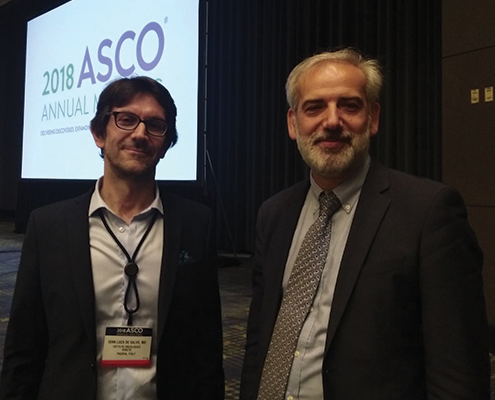 CHICAGO – A new chemotherapy strategy improves cure rates for children with rhabdomyosarcoma (a rare cancer of the muscle tissue) who are at high risk for cancer recurrence. In a randomized phase III clinical trial, adding six months of low-dose maintenance chemotherapy after initial treatment increased the 5-year overall survival rate from 73.7% to 86.5%. Children with rhabdomyosarcoma who are alive at five years are considered cured, as tumor recurrence is very rare.
CHICAGO – A new chemotherapy strategy improves cure rates for children with rhabdomyosarcoma (a rare cancer of the muscle tissue) who are at high risk for cancer recurrence. In a randomized phase III clinical trial, adding six months of low-dose maintenance chemotherapy after initial treatment increased the 5-year overall survival rate from 73.7% to 86.5%. Children with rhabdomyosarcoma who are alive at five years are considered cured, as tumor recurrence is very rare.
These findings will be presented in ASCO’s Plenary Session, which features four studies deemed to have the greatest potential to impact patient care, out of the more than 5,800 abstracts featured as part of the 2018 American Society of Clinical Oncology (ASCO) Annual Meeting.
“We have been treating rhabdomyosarcoma the same way for more than 30 years, and although different approaches have been tried, this is the first randomized trial in rhabdomyosarcoma to show improved outcomes. By using existing medicines in new ways, we are establishing a new standard of care and, most importantly, we’re helping children and young adults with this rare cancer live longer, with less risk of their cancer returning,” said lead study author Gianni Bisogno, MD, PhD, a professor at the University Hospital of Padova in Italy and Chair of the European Paediatric Soft tissue Sarcoma Study Group.
Rhabdomyosarcoma originates in the muscle tissue and can occur in any part of the body, but it is most often found in the head, neck, pelvis, and abdomen. Rhabdomyosarcoma is rare, accounting for 4% of all childhood cancers (about 350 children are diagnosed with this cancer each year in the United States).
The prognosis for rhabdomyosarcoma is generally good – 80% of children can be cured with modern treatment, which includes high-dose chemotherapy, radiation, and surgery. However, among children who have metastasis at diagnosis or a recurrence after initial treatment, only 20-30% can be cured.
About the Study
This trial enrolled patients 6 months to 21 years of age who were considered at high risk for recurrence due to having large tumors located in a part of the body that is difficult to treat (e.g., the head).
After completing the standard initial treatment, 371 patients (79% of whom were 10 years old or younger) were randomly assigned to either stop treatment (the former standard of care) or receive six months of maintenance therapy with low doses of two chemotherapy medicines (intravenous vinorelbine and oral cyclophosphamide).

Key Findings
At five years from diagnosis, the disease-free survival (defined as five years without tumor recurrence or death from any cause) was 68.8% in the standard treatment group vs. 77.6% in the maintenance group, and overall survival rates were 73.7% vs. 86.5%, respectively.
The most common side effect in the maintenance group was low blood cell count, though it was usually mild. Febrile neutropenia (a serious side effect involving fever due to very low levels of white blood cells) occurred in 25% of patients. Infection rates were much lower with maintenance treatment than after initial standard chemotherapy, and neurologic side effects resolved after treatment ended. However, as with most kinds of chemotherapy, long-term side effects are still possible, and patients will continue to be monitored.
Next Steps
The findings of this trial have already changed the standard of care in Europe, where investigators shared the results with soft tissue sarcoma study group institutions in 14 countries. As the standard of care is somewhat different in the United States, there is a need for further study to understand how to integrate maintenance therapy into existing treatment protocols.
This study received funding from Fondazione Città della Speranza, Italy.


